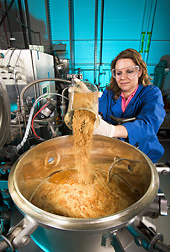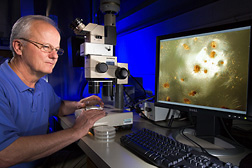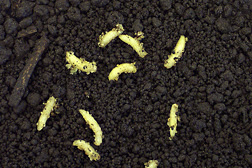Multiplying Metarhizium
Scientists tap sturdy new form
of fungus for better biopesticides.
Metarhizium anisopliae is one mold you might not mind having around. Instead of growing on bread or shower curtains, it prefers the bodies of ticks and insect pests, such as termites, locusts, tsetse flies, and others.
Indeed, a Metarhizium strain dubbed “F52” is the chief active ingredient in four federally registered mycoinsecticide products for controlling soft-bodied ticks and certain beetles and weevils.
Now, even better mycoinsecticides—targeting soil-dwelling insect pests—could be on tap, thanks to ARS scientists’ discovery that Metarhizium can produce specialized clumps of fungal cells called “microsclerotia.”
Agricultural Research Service microbiologist Mark A. Jackson and ARS entomologist Stefan Jaronski made the discovery in 2004 and have since developed a patent-pending method of churning out billions of microsclerotia inside vats called “fermentors.”
Making More and Tougher Fungi
Before the duo’s finding, only plant-disease-causing fungi like Sclerotinia sclerotiorum were reported to produce microsclerotia—not their insect-infecting brethren.
|
|
“We found with Metarhizium that we could produce these sclerotial bodies in liquid culture under certain conditions,” says Jackson, with ARS’s National Center for Agricultural Utilization Research in Peoria, Illinois. “The advantage of this is that we can now make a form of this fungus that can survive drying and storage for easy application by farmers to the soil to kill insects.”
Traditionally, the form of choice for making mycoinsecticides has been the conidia, or spore, which forms thin tubes that penetrate an insect host’s outer shell, or cuticle. The fungus only infects certain insect hosts, however, and never people, pets, or livestock.
“Metarhizium’s conidia are like little time bombs,” explains Jaronski, with ARS’s Northern Plains Agricultural Research Laboratory in Sidney, Montana. “They don’t germinate until they contact the insect cuticle. Then, they use a combination of mechanical pressure and a cocktail of enzymes to breach the cuticle and invade the insect’s circulatory system. The infected insect invariably dies within a few days.”
|
|
In a standard production approach, Metarhizium is grown on nutritious cakes called “solid substrate.” The fungus produces abundant conidia, which are then collected, dried, and coated onto granules made of corn grits or other granular carriers or mixed directly into the soil. But the solid-substrate approach is time consuming and labor intensive for this purpose, notes Jackson.
Microsclerotia—tight bundles of pigmented fibers that resemble pepper flakes—are a far tougher form of fungus. Moreover, they serve as a safe haven on which Metarhizium’s conidia can be readily produced to infect insects that get too close while crawling about in the soil.
Other researchers have produced granules from air-dried, regular mycelium (the fungus’s main body) or mycelium encapsulated in a polymer, says Jaronski. But these forms suffer from poor shelf life or cost too much for most farmers.
Cheaper and Faster, Too
In studies at Sidney using Metarhizium strain F52, conidia-only granules germinated 7-10 days after being applied to soil. Microsclerotia-based formulations germinated within 4 days and produced greater numbers of spores.
Jackson partly credits the microsclerotia’s increased germination rate to their ability to tolerate lower soil moisture. Another factor may be the sheer number of microsclerotia that can be produced and applied to the soil using the liquid-culture technique he and Jaronski developed.
The researchers’ current microsclerotia production rate is 30 grams of wet fungal biomass (fermentation material containing fungal cells) per liter in about 4 days. Solid-substrate systems, by comparison, take 2 weeks to produce commercial quantities of conidia, and more time is needed to prepare the granules. “The solid-substrate system has its place in the production of some fungi, but it’s more costly,” says Jackson.
Microsclerotia can also be formulated into granules and sized more easily than conidia-based formulations. This makes microsclerotia more compatible with farmers’ seed planters and pesticide granule applicators. Biopesticide makers stand to benefit, too: “Using microsclerotia should allow companies that make mycoinsecticides to get into markets where, ostensibly, the size and shape of their products have kept them out,” Jaronski says. Microsclerotial granules should also readily qualify for the organic crop market, whereas the binders used with conventional granular carriers disqualify those granules, he adds.
A Moldy Match for Maggots
Since 2004, Jaronski has teamed with North Dakota State University scientists in Fargo to test conidia-coated corn-grit granules of F52 against the fly species Tetanops myopaeformis, whose maggot stage is a top pest of sugar beets nationwide.
The results of their tests have been encouraging, especially when Metarhizium is combined with oat or rye cover crops as part of an integrated pest management approach. (See “Beeting Back the Enemy,” Agricultural Research, Sept. 2006, pp. 16-17.)
“Under low insect pressure, these fungi work as well as the insecticide terbufos,” Jaronski reports. “For high insect pressure, we’re looking at integrating the fungus with a live cover crop. So far, the two are giving us significant protection with no loss of yield.”
In 2006, Jaronski began comparing conidia-only corn-grit granules with microsclerotia-based ones derived from the liquid-culture method for which ARS filed a patent in September 2007.
In laboratory assays, around 25 percent of sugarbeet root maggots exposed to the spores produced on corn-grit granules in clay soils had died by 3 weeks. In microsclerotia-treated soil, 100 percent were dead in the first week. These observations reflect the faster and greater conidia production by microsclerotia in soil. During 2007 field trials, beets in microsclerotia-treated plots also suffered fewer scars from maggot feeding.
Oddly enough, the researchers have been unsuccessful in using their liquid-culture technique to obtain microsclerotia from other insect-killing fungi used as biological control agents—notably Beauveria bassiana and Paecilomyces fumosoroseus. But they were able to produce microsclerotia with several different strains of the Metarhizium fungus.
“That’s one of the strange things about these microsclerotia,” says Jaronski. “The process for producing them only works with Metarhizium.” That hasn’t deterred a major biopesticide maker from taking notice, though. “The technique is applicable not just to sugarbeet root maggots, but to any soil-dwelling pest that’s attacked by this fungus,” Jaronski says.—By Jan Suszkiw, Agricultural Research Service Information Staff.
This research is part of Crop Protection and Quarantine (#304) and Quality and Utilization of Agricultural Products (#306), two ARS national programs described on the World Wide Web at www.nps.ars.usda.gov.
Mark A. Jackson is in the USDA-ARS Crop Bioprotection Research Unit, National Center for Agricultural Utilization Research, 1815 N. University St., Peoria, IL 61604; phone (309) 681-6283, fax (309) 681-6693.
Stefan Jaronski is in the USDA-ARS Pest Management Research Unit, Northern Plains Agricultural Research Laboratory, P.O. Box 463, Sidney, MT 59270; phone (406) 433-9486, fax (406) 433-5038.
"Multiplying Metarhizium" was published in the September 2008 issue of Agricultural Research magazine.










